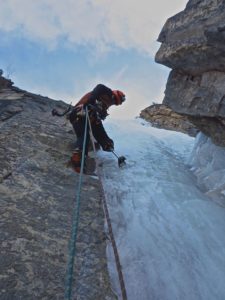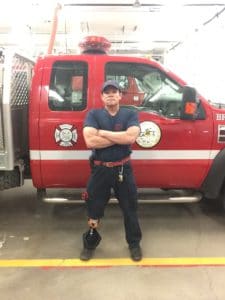The job of a first responder is very challenging. In an earlier article I stressed the importance of mental health. I am now turning my focus to the physical aspects we face at work. It is imperative that we stay in the best shape possible. We owe it to the community we serve and our fellow brothers and sisters.
It’s not as easy as one would think. Many firefighters have turned to CrossFit, which is good for some but not for everyone. One of the best things your department can do is provide time and equipment to stay in top physical shape. We need to be cardiovascular fit, strong, flexible and keep our minds in shape. Shift work can make it difficult to train so we must train at work.
I have never been one who loves the gym or working-out inside. With our jobs we need to find balance and learn to cross train. With this said, most of us need to hit the gym at work. Some of us work 24s and others work 48s; my dept is on a 48 hour shift. Working shifts means you have to utilize whatever workout your dept. offers. We have a gym we can go to and exercise equipment in our station. I choose to utilize our station equipment.
We have stationary bikes, elliptical machines, free weights and a nautilus weight machine. Personally I like to spin. Cardiovascular training is just as important as weight training. Some departments use cross fit, which is good but be careful jumping into this if you are out of shape. Cross Fit is something you should and can work up to. Some departments are using firefighter specific workouts. Whatever you do it should include cardio.
Cardiovascular training, in my opinion, is necessary. When you are working a structure fire you are only as strong as the weakest link on your team. We go in as a team and come out as a team. If one of the members of your team is not up to par with the others, you can only stay interior as long as the weakest link. It is detrimental to the unit if one of your members burns through a bottle of air at twice the rate of the others. You may be doing an interior attack or a search. If one member is low on air we all must exit the building. This is non-productive. It is one of the reasons cardiovascular training is so important. Of course the main reason is our heart is a muscle. If we don’t exercise it we will be at risk of a cardiac event. This could lead to what is called an incident within an incident. This incident can cause your brothers and sisters a great amount of stress, PTSD, and may even lead to a suicide in your dept.
While I push the importance of cardio, weight training is also essential. You don’t have to lift heavy weights, in fact it’s better to lift light with high reps. Going with light weights will increase your strength while elongating your muscles, which reduces the chance of injury on the job.
Core body strength and strengthening your back is imperative. With this said, you need to work your stomach and back. Next to heart attacks, back injuries are probably the number one reason firefighters and EMS personnel miss work. Cardiovascular training, weight training and core body strength can be achieved by making sure you train while on shift. If you don’t have equipment, find a workout program specific to the job. I encourage all chief officers to allow at least 1 hour of part of a day; 2 hours is optimal. You should always start and end your workout with stretching or yoga. On your days off, make your workouts fun.
You can run, bike, ski, hike, swim, paddle, climb, row or find something else to do outside. Personally I like to cross train with climbing, biking, skiing, stand up paddling and swimming. Find something that is fun in your area. It can be something different; in fact a great option is organized sports. At the very least, walk swiftly for 3 miles.
 Personally, climbing is my favorite past time. I find climbing is the one sport that lets my mind rest. When I climb I can only think about the climb. This frees your mind by allowing it to focus only on the task of making it to the top. Climbing also increases strength and flexibility. I am fortunate to have the mountains and dessert as my playground. The last thing I would like to discuss is TRE therapy or meditation.
Personally, climbing is my favorite past time. I find climbing is the one sport that lets my mind rest. When I climb I can only think about the climb. This frees your mind by allowing it to focus only on the task of making it to the top. Climbing also increases strength and flexibility. I am fortunate to have the mountains and dessert as my playground. The last thing I would like to discuss is TRE therapy or meditation.
I find it difficult to meditate as my mind wanders. TRE therapy is taught in 35 countries. It stands for tension and trauma release therapy. I recently learned this and it is very easy and can be done at work or home. TRE includes a series of 7 steps. These steps end with the TRE tremor position. TRE uses the body’s innate process of controlled shaking to reduce stress and trauma, including PTSD. This revolutionary approach is doing wonders for me.
In conclusion, we are public servants. With this comes a responsibility to keep in shape. As we get older the stress of the job and life’s stressors can lead us to cope in unhealthy ways. I encourage you all to make a commitment to your community and fellow brothers and sisters. Of course we can’t control our genetic makeup, but we can make a commitment to physical and mental health. Let’s turn the tide towards less injury, death, PTSD and suicide of first responders. With a commitment we can turn the tide.
 Jeff lost his right leg below the knee at the age of 50 as the result of a skiing injury. Instead of wallowing in pity, Jeff rebounded physically and mentally through physical therapy and exercise. He returned to work as firefighter/EMT a year later and is now back on the job fulltime. He strives to be the best firefighter/EMT he can be, and also to be an inspiration to others. Jeff welcomes your thoughts and comments at [email protected].
Jeff lost his right leg below the knee at the age of 50 as the result of a skiing injury. Instead of wallowing in pity, Jeff rebounded physically and mentally through physical therapy and exercise. He returned to work as firefighter/EMT a year later and is now back on the job fulltime. He strives to be the best firefighter/EMT he can be, and also to be an inspiration to others. Jeff welcomes your thoughts and comments at [email protected].
- California Casualty Earns Financial Stability Rating® of A, Exceptional, From Demotech, Inc. - April 28, 2025
- Music & Arts Grant Recipients – 2024 - December 13, 2024
- Understanding Auto and Home Insurance Rate Changes - December 3, 2024
